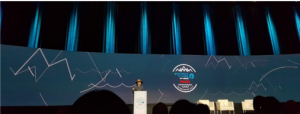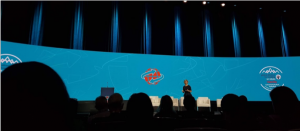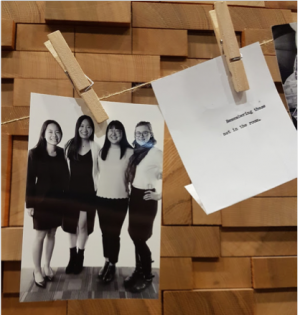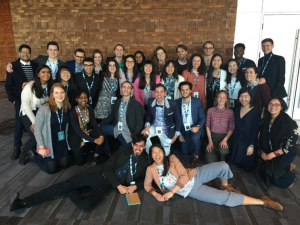
Rudia Nam is a third-year UBC student majoring in International Relations and a member of the 2018-19 Co-ops in Schools (CIS) cohort. She shares her experience as a member of the Young Leader Delegate at the 2019 Global Alliance for Banking on Values Summit.
As one of the thirty-five young leader delegates at the 2019 Global Alliance for Banking on Values Summit, I really had no clue what I was getting myself into.
A bit about myself, I am a third-year International Relations student at UBC. Studying different areas such as history, economics, and political science, I am faced with large issues and learn about many high-level abstractions that are sometimes hard to concretely address. What I really seek to explore are real and effective solutions that we could take to empower individuals, communities, and nations.

I applied to be a part of this delegation out of pure interest to learn how on earth banking could address one or even all three of the issues around migration, climate change, and the #MeToo movement. I came into the conference having felt most connected to the issue of migration. As a second-generation Korean-Canadian woman, I have always felt in the ‘in-between’ of not fully belonging to either my Korean or Canadian culture.
The Global Alliance for Banking on Values(GABV) is a network of banking leaders from around the globe who have committed to achieving positive change in banking. Their collective is to “change the banking system so that it is more transparent, supports economic, social and environmental sustainability, and is composed of a diverse range of banking institutions serving the real economy.”
The GABV members share a common mission to use finance to deliver sustainable economic, social and environmental development, with a focus on helping individuals fulfil their potential and build stronger communities.
The GABV Summit offered me an avenue to learn about how finance and banking could be a tangible tool to address the most pressing issues of our day-and-age: migration, #MeToo, and climate change.
Pre-Summit: February 5, 2019
CityHive organized two pre-Summit meet-ups (one earlier in February and one the day before the summit) with the Young Leader Delegation to help us feel more comfortable in understanding the premise of GABV and facilitating a space where we could openly connect with one another based on our own stories, goals, and interests to one another.
The first evening we met, we had the opportunity to have Tamara Vrooman, CEO of Vancity and Paula Martin, the Advisor to the CEO, come and talk to us about how Vancity is one of the first Canadian financial institution to be invited to GABV.
Hearing from Vrooman about the humble and community-based origins of Vancity, as well as the 6 principles of values-based banking, helped give me more context and faith in the power of banking. This evening helped me understand that financial responsibility meant much more than just saving at a convenient bank, but to understand and investigate where your hard-earned money is going and what banks may be using it to support.
Sharing and listening to my fellow peers, it was clear that many of us felt that our age would prevent us from contributing since we felt as though we didn’t have expertise or experiences that could be of value in upcoming conversations with banking and finance leaders during the Summit. Yet, the power of naming those fears and feeling supported in knowing that many of us felt the same way, offered a great deal of comfort and ease as we waited in anticipation for the Summit.
 Pre-Summit: February 18, 2019
Pre-Summit: February 18, 2019
Our second delegates meeting was at the Vancity headquarters with Anna Laycock, CEO of the Finance Innovation Lab, where she leads work to build a financial system that serves people and planet. While Laycock shared the value of the work she has done and continues to do, I found her vulnerability to be most impactful. She told stories of her past and present and offered many words of encouragement for us to feel empowered as young people to change these seemingly entrenched systems. Laycock urged us: we need leaders who are both vulnerable and broken because that is what gives us the power to take others with us in the change we are trying to see in the world. If the world is broken, how can we relate better to these broken systems as the flawed and broken humans we are?
She gave us a powerful example of her favourite word: kintsugi. It refers to a Japanese craft where a broken teapot is put back together with gold or bronze lacquer. Instead of being thrown out or hidden, it is re-built again to be something more beautiful than before.
Lastly, Laycock gave us some pointers on the things we need to be leaders in this world: to have self-awareness, purpose; and a set of tools and skills.
 After these two sessions listening to various leaders in the GABV movement and spending time with the delegation, I felt more hopeful, aware, and supported in the conversations to come over the next two days.
After these two sessions listening to various leaders in the GABV movement and spending time with the delegation, I felt more hopeful, aware, and supported in the conversations to come over the next two days.
The evening ended with a dinner consisting of all the GABV participants at the Vancouver Convention Center. We were welcomed by the GABV organizers and we listened to a panel consisting of various banking leaders speaking about how the GABV movement has impacted their own banks located around the world. I found that this first dinner was a valuable opportunity to introduce ourselves as Young Leader Delegates and to share a lovely meal with a number of banking leaders!
My GABV Summit Experience: February 19-20, 2019
The day began with breakfast and an opening session consisting of a welcome from Janet Austin (Lieutenant Governor of B.C.) and territorial welcome from Khelsilem Tl’akwasikan (Squamish Nation Councillor).
Following the welcoming remarks, GABV members had a short panel discussing the responsibility of banking and how it connects to different social challenges.
 The them of disruption came up, and panelists discussed how the word could be re-invented in the finance sector to depict a renewal—a new picture of life as an opportunity for all people to participate in new ways of banking. All the while, there was an emphasis on putting human dignity at the core of the work of the GABV.
The them of disruption came up, and panelists discussed how the word could be re-invented in the finance sector to depict a renewal—a new picture of life as an opportunity for all people to participate in new ways of banking. All the while, there was an emphasis on putting human dignity at the core of the work of the GABV.
Migration Panel
 Excited and thinking about disrupting systems, we entered our first plenary session on the topic of migration.
Excited and thinking about disrupting systems, we entered our first plenary session on the topic of migration.
Each session was structured to begin with remarks from a featured keynote speaker, followed by a panel consisting of GABV leaders and other representatives to discuss what more needs to be done to address the issue at hand.
The Migration session featured Tima Kurdi from the KurdiFoundation, a refugee advocate and activist and aunt of Alan Kurdi, “the boy on the beach” whose image took the world by storm and raised awareness of the ongoing Syrian refugee crisis.
In her sharing, Kurdi laid out her goal of planting a seed of hope in the minds and hearts of all those who would hear her family’s story of fleeing crisis. She moved many to tears with her heart-wrenching narrative that her relatives had to face and what many refugees continue to face. She argued that it only took one image to move people to be human, thus she continues her work to continue to urge people to use their voice to protect others. This protection she calls us to is also the responsibility of bankers.
Migration Design exChange
 In the 12 design exchanges that followed, all conference participants chose a group and were given the opportunity to discuss the issues and potential courses of action regarding topics such as activism, technology, financial literacy, and banking for immigrant communities.
In the 12 design exchanges that followed, all conference participants chose a group and were given the opportunity to discuss the issues and potential courses of action regarding topics such as activism, technology, financial literacy, and banking for immigrant communities.
I made my way to the Design exChange titled, “Disrupting financial systems for social good”. Individuals in my group discussion brought up questions about how we can make international crises hit closer to home by changing public attitudes and what the conception of ‘home’ looks like. Others argued that extreme racism is still rampant and disenfranchises groups, whereas others felt passionate about impact lending and the funding of organizations where leadership does not reflect the diversity of our world. We concluded with more questions than when we had begun, and all agreed that collaboration and diversity must be a goal of the GABV.
Migration Closing Panel
At the closing panel, Linda Lopez, from the Office of Immigrant Affairs Office of the Mayor in Los Angeles, presented three takeaways from the migration session. First, there is real opportunity for individuals to bring skills, resources, and tools to displaced communities in ways that are mutually beneficial. Second, taking risks relates to the role of bankers because finance leaders can leverage their power and models of profit-making to advocate for social good and inclusivity. And lastly, Lopez reflected about how we can serve local communities while building trust in a sustainable model.

#MeToo Panel
This session opened with keynote speaker Musimbi Kanyoro, the CEO of the Global Fund for Women. Her organization supports funding efforts to support girls and women in Zimbabwe and throughout Africa. Kanyoro shared a story of a schoolgirl named Florence, a schoolgirl who received funding to support other schoolgirls in Zimbabwe. She illustrated the value of investing in a women’s rights movement because they have the ability to identify the solution to what they need.

Kanyoro continued to argue that grassroots movements are usually thought to be as financially irresponsible, and therefore there is little incentive to provide funding. Kanyoro shared with the audience that the bigger issue is not financing women, but that the need is to focus on their human rights. She called for bankers to trust the grassroots level and consider giving to women’s groups around the world since when you mobilize philanthropic work, accountability is created. Kanyoro ended with an impactful question: “If we do indeed believe that women and girls matter…Where is the money?”
In the panel and 12 design exchanges that followed, topics such as social inclusion for marginalized groups like women, the poor, the homeless, and Indigenous peoples were explored in the realm of banking and investment.
#MeToo Design exChange
I attended an exChange called “Giving customers a voice,” and the group discussed diversity and social inclusion. The initial questions brought to the table included how to involve customers as valued humans in banking while putting human dignity at the center since members want to feel respected and informed as customers. Several individuals brought up the concerns of the metrics involved for measuring the level of diversity and inclusion in bank leadership and the communities it serves. Lastly, various banking leaders in the room expressed that the bank-customer relationship is not solely unilateral and rests on the customers and banks understanding one another.

Climate Change Panel
On Day 2, our final theme was global climate change. The keynote speaker was Sheila Watt-Cloutier, an author and Canadian Inuit activist. Watt-Cloutier spoke about how Inuit communities provide the human face to the Arctic. Living in snow and ice all year-round, she shared of the Inuit characteristics of resiliency, courage and patience, which have developed through their connected way of life to the ice and snow.
In the doom of climate change, the Arctic landscape is quickly changing. Watt-Cloutier told the audience that climate change becomes not only saving the polar bears, but also rescuing the families and communities that have lived thousands of years in the snow and ice. From this, she argued that if the Arctic is protected, you also save the rest of the world. Her aim is to change the discourse of climate change, linking it to human rights and focusing on collective rights. From colonial trauma, climate change offers a new intergenerational and environmental trauma to Inuit communities and their livelihoods.

In her closing remarks about what can be done to address climate change, Watt-Cloutier encouraged us to advocate together in a values-shaped manner. She emphasized how partnerships need to be done in the right way because communities already know what needs to be done. The focus should be on the people and their resourcefulness.
Climate Change Design exChange
The following panel and design exchange ranged from policy-making and regulators and working with local governments to the role of economics in creating a sustainable society. I decided to attend the session about educating the next generation of climate conscious leaders in line with the UN SDGs.
The majority of my group echoed concerns about what happens when we leave the conference and the problem of romanticizing the SDGs and current climate change efforts since they simply are not enough. The education of young children, adolescents, young adults and older adults was discussed at great length, and included back and forth about how educational programs are often short-term not sustainable, thus the small initiatives to address climate change locally were not sustainable in the long-run. Furthermore, folks from different organizations spoke about the importance of educating their own staff on issues of environmentalism to address the gap of uninformed adults.
While our design exchange ran out of time, it was encouraging to see a number of my fellow young leader delegates vocalizing the need for older adults working in banks and employees to also receive education and be inspired to address climate change in whatever means possible. Especially since education institutions are seen as the hub for ideas and chance, my peers and I value the role of education and system-changing across all ages and occupations.

The Young Leader Delegation Experience
Participating in the GABV Summit as a part of the Young Leader Delegation was a phenomenal experience!
I have never felt more encouraged and inspired by a group of people. Although we were all so different from each other, it was clear that we all held the same values in our own walks of life—as students and working professionals.
I am so grateful to have met 34 other passionate individuals, and took comfort in seeing a familiar face in the midst of busy dining rooms or sharing a smile in the main room where the exChanges took place.
But these people were more than just a familiar face—my fellow delegates amazed me with what unique experiences, questions, comments, and stories that they brought to the Summit. Often, I found that the comments made by other young leader delegates in our Design Exchanges were the most impactful and meaningful contributions, causing the response and reflections of other older individuals in the room.
 I am so proud of the impact the young leaders delegation was able to make in the available spaces we were present in. From our first pre-session to our final debrief together on the last day of the Summit, I could visibly see how our confidence in our ability to influence, disrupt, and change had increased.
I am so proud of the impact the young leaders delegation was able to make in the available spaces we were present in. From our first pre-session to our final debrief together on the last day of the Summit, I could visibly see how our confidence in our ability to influence, disrupt, and change had increased.
I firmly believe that the presence of just a few of us in spontaneous conversations with banking leaders did just enough to challenge these values-based advocators to reflect more on what else they could be doing to move the GABV movement along.
 My Takeaways:
My Takeaways:
2019 marks the 10-year anniversary of the Global Alliance for Banking on Values. I do not know why this movement has not made more of a scene in media or in my economics classes at UBC, but now it is something that I will continue to advocate for people to be more informed about. The movement is based on values that I hold personally close to my heart and to see the work that they are striving to do encourages me to have more hope in the sustainability of the finance and banking sector.
The progressive nature of the GABV was evident in the structure of the Summit and all topics, discussions, panels and speakers and I am filled with respect for the banking work being done around the globe. Prior to the conference, I had never thought of myself to be a banker, yet by the end of the summit, I believe firmly that any person that deals with any finances, big or small, is considered a banker. As bankers, our money needs to support and be invested in causes that support the human dignity of others and help address the challenges in the world.

I had also always struggled with having confidence that I held much power or knowledge to incite change in any system, let alone the banking industry. This Summit encouraged me and taught me that leaders today do care about the younger generations because they view us as those spearheading the future. If we are to work towards change, we should recognize the fact that change will not be seen in the lifetime of the generations before us and that the responsibility does also lay on the younger generations.
 To hand-off this legacy well, I am grateful to the GABV for thinking to organize a group of young leaders to be a part of the conversations traditionally held in closed meeting rooms with exclusive executive members only. I can see how GABV values diversity and how they have made very applaudable efforts to include those who are not typically in the room.
To hand-off this legacy well, I am grateful to the GABV for thinking to organize a group of young leaders to be a part of the conversations traditionally held in closed meeting rooms with exclusive executive members only. I can see how GABV values diversity and how they have made very applaudable efforts to include those who are not typically in the room.
Although I have many takeaways about my role in traditional modes of finance, I wish that there were more intentional spaces created for the Young Leaders Delegation. Speaking to several of my peers, we felt very empowered at the Summit to have the agency to change systems and that we would be listened to when we provided input. A couple of the delegates were invited to sit on the closing panel of the Summit, and it was amazing to see some younger voices being represented. But, I wonder what future discussions could look like if at future GABV summits, the regular presence of youth on these various panels was implemented? I feel that there is a valuable and almost missed opportunity to tap into a resource of different opinions and new ideas that could potentially lead to another amazing step forward for the GABV movement!

Finally, I would like to extend my warmest thanks to Vancity, GABV, and CityHive for allowing me to attend the GABV Summit this year. I extend my deepest appreciation to all my fellow delegates and to Veronika and Tesicca of CityHive who helped bring a wonderful, strong-willed, intelligent, and radiant group of young leaders together to disrupt the spaces at GABV and to continue to feel empowered to do so wherever we may play, work, study and live!